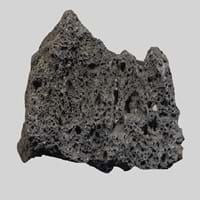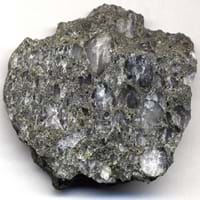Definition
Scoria is a dark-colored extrusive igneous rock with abundant round bubble-like cavities
Conglomerate is a sedimentary rock which forms from rounded gravel and boulder sized clasts which are cemented together in a matrix
Discoverer
Unknown
Unknown
Etymology
From late Middle English (denoting slag from molten metal), from Greek skōria refuse, from skōr dung
From Latin conglomeratus, to roll together, i.e. from com together + glomerare to gather into a ball, from glomus (genitive glomeris) a ball
Class
Igneous Rocks
Sedimentary Rocks
Sub-Class
Durable Rock, Medium Hardness Rock
Durable Rock, Soft Rock
Group
Volcanic
Not Applicable
Other Categories
Fine Grained Rock, Opaque Rock
Coarse Grained Rock, Opaque Rock
Texture
Vesicular
Clastic
Color
Black, Brown, Dark Grey to Black, Red
Beige, Black, Brown, Buff, Light to Dark Grey, Orange, Rust, White, Yellow
Durability
Durable
Durable
Scratch Resistant
Yes
Yes
Appearance
Glassy and Vesicular
Shiny and Rounded
Interior Uses
Decorative Aggregates, Interior Decoration
Decorative Aggregates, Floor Tiles, Homes
Exterior Uses
Garden Decoration, Paving Stone
As Building Stone, As Facing Stone, Garden Decoration, Office Buildings, Roof Tiles
Other Architectural Uses
Curbing
Curbing
Construction Industry
Cement Manufacture, Construction Aggregate, for Road Aggregate, In landscaping and drainage works
As Dimension Stone, Cement Manufacture, Construction Aggregate, for Road Aggregate, Roadstone
Medical Industry
Not Yet Used
Not Yet Used
Antiquity Uses
Artifacts, Monuments, Sculpture
Artifacts, Monuments, Sculpture, Small Figurines
Commercial Uses
As a traction material on snow-covered roads, Creating Artwork, High-temperature insulation, In gas barbecue grills
Cemetery Markers, In aquifers, Tombstones
Types
Not Available
Not Available
Features
Available in Lots of Colors and Patterns, Generally rough to touch, Surfaces are often shiny
Clasts are smooth to touch, Is one of the oldest rock, Matrix variable
Archaeological Significance
Famous Monuments
Data Not Available
Data Not Available
Famous Sculptures
Data Not Available
Data Not Available
Formation
Scoria forms when magma containing huge amount of dissolved gas flows from a volcano during an eruption.
Conglomerate forms where sediments consisting mainly of pebble and cobble-size clasts at least two millimeters in diameter starts accumulating.
Mineral Content
Apatite, Biotite, Calcite, Feldspar, Hematite, Hornblade, Ilmenite, Magnetite, Olivine, Pyroxene, Quartz, Silica
Clay, Sand, Silica, Silt
Compound Content
Ca, NaCl
NaCl, CaO
Types of Metamorphism
Burial Metamorphism, Cataclastic Metamorphism, Contact Metamorphism
Burial Metamorphism, Cataclastic Metamorphism, Regional Metamorphism
Types of Weathering
Biological Weathering, Chemical Weathering, Mechanical Weathering
Not Applicable
Types of Erosion
Chemical Erosion, Coastal Erosion, Glacier Erosion
Chemical Erosion, Coastal Erosion
Grain Size
Fine Grained
Coarse Grained
Fracture
Conchoidal
Uneven
Porosity
Highly Porous
Highly Porous
Luster
Subvitreous to Dull
Dull
Cleavage
Perfect
Non-Existent
Toughness
2.1
Not Available
Specific Gravity
Not Available
2.86-2.88
Transparency
Opaque
Opaque
Density
Not Available
1.7-2.3 g/cm3
Specific Heat Capacity
Not Available
Resistance
Heat Resistant, Impact Resistant, Pressure Resistant, Wear Resistant
Heat Resistant
Deposits in Eastern Continents
Asia
Afghanistan, Indonesia, Japan, Russia
China, India, Kazakhstan, Mongolia, Russia, Uzbekistan
Africa
Ethiopia, Kenya, Tanzania
Namibia, Nigeria, South Africa
Europe
Greece, Hungary, Iceland, Italy, Turkey
Austria, Denmark, Germany, Great Britain, Netherlands, Norway, Poland, Sweden, Switzerland, United Kingdom
Others
Not Yet Found
Greenland
Deposits in Western Continents
North America
Bahamas, Barbados, Canada, Costa Rica, Cuba, Jamaica, Mexico, USA
Canada, USA
South America
Argentina, Chile, Ecuador, Peru
Brazil
Deposits in Oceania Continent
Australia
New Zealand, Western Australia
New South Wales, New Zealand
All about Scoria and Conglomerate Properties
Know all about Scoria and Conglomerate properties here. All properties of rocks are important as they define the type of rock and its application. Scoria belongs to Igneous Rocks while Conglomerate belongs to Sedimentary Rocks.Texture of Scoria is Vesicular whereas that of Conglomerate is Clastic. Scoria appears Glassy and Vesicular and Conglomerate appears Shiny and Rounded. The luster of Scoria is subvitreous to dull while that of Conglomerate is dull. Scoria is available in black, brown, dark grey to black, red colors whereas Conglomerate is available in beige, black, brown, buff, light to dark grey, orange, rust, white, yellow colors. The commercial uses of Scoria are as a traction material on snow-covered roads, creating artwork, high-temperature insulation, in gas barbecue grills and that of Conglomerate are cemetery markers, in aquifers, tombstones.










